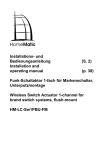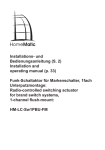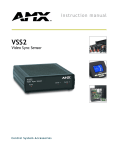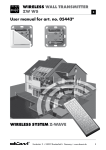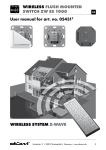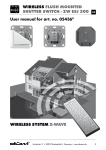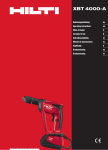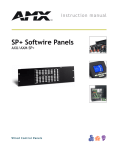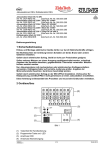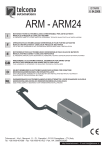Download Installations- und Bedienungsanleitung (S. 2) Installation
Transcript
Installations- und Bedienungsanleitung Installation and operating manual (S. 2) (p. 38) Funk-Rollladenaktor 1-fach für Markenschalter, Unterputzmontage Wireless Shutter Actuator 1-channel for brand switch systems, flush-mount HM-LC-Bl1PBU-FM Inhaltsverzeichnis 1. Ausgabe Deutsch 02/2012 Dokumentation © 2012 eQ-3 Ltd., Hong Kong Alle Rechte vorbehalten. Ohne schriftliche Zustimmung des Herausgebers darf dieses Handbuch auch nicht auszugsweise in irgendeiner Form reproduziert werden oder unter Verwendung elektronischer, mechanischer oder chemischer Verfahren vervielfältigt oder verarbeitet werden. Es ist möglich, dass das vorliegende Handbuch noch drucktechnische Mängel oder Druckfehler aufweist. Die Angaben in diesem Handbuch werden jedoch regelmäßig überprüft und Korrekturen in der nächsten Ausgabe vorgenommen. Für Fehler technischer oder drucktechnischer Art und ihre Folgen übernehmen wir keine Haftung. Alle Warenzeichen und Schutzrechte werden anerkannt. Printed in Hong Kong Änderungen im Sinne des technischen Fortschritts können ohne Vorankündigung vorgenommen werden. 1 Hinweise zu dieser Anleitung . . . . . . . . . . . . . . 4 2Gefahrenhinweise . . . . . . . . . . . . . . . . . . . . . . . 5 3Funktion . . . . . . . . . . . . . . . . . . . . . . . . . . . . . . 8 4Adapter . . . . . . . . . . . . . . . . . . . . . . . . . . . . . . 11 5 Allgemeine Systeminformation zu HomeMatic 15 6 Allgemeine Hinweise zum Funkbetrieb . . . . . . 15 7Installation . . . . . . . . . . . . . . . . . . . . . . . . . . . . 16 7.1 Installation des HomeMatic UnterputzRollladenaktors . . . . . . . . . . . . . . . . . . . . . . . . 18 8Bedienung . . . . . . . . . . . . . . . . . . . . . . . . . . . . 24 8.1 Einfache Bedienung über Tastwippe . . . . . . . . 24 8.2Anlernen . . . . . . . . . . . . . . . . . . . . . . . . . . . . . 24 8.3 Bedienfunktionen nach Anlernen . . . . . . . . . . 30 9 Werkseinstellungen wieder-herstellen . . . . . . . 31 10 Rückmeldungen der Geräte-LED . . . . . . . . . . 32 10.1Blinkcodes . . . . . . . . . . . . . . . . . . . . . . . . . . . . 32 10.2 Anzeige des Betriebszustandes . . . . . . . . . . . 32 11 Verhalten nach Spannungswiederkehr . . . . . . 33 12 Wartung und Reinigung . . . . . . . . . . . . . . . . . . 34 13 Technische Daten . . . . . . . . . . . . . . . . . . . . . . 35 104216 / V 1.2 2 3 1 Hinweise zu dieser Anleitung 2Gefahrenhinweise Lesen Sie diese Anleitung sorgfältig, bevor Sie Ihre HomeMatic Komponenten in Betrieb nehmen. Bewahren Sie die Anleitung zum späteren Nachschlagen auf! Wenn Sie das Gerät anderen Personen zur Nutzung überlassen, übergeben Sie auch diese Bedienungsanleitung. Bei Sach- oder Personenschäden, die durch unsachgemäße Handhabung oder Nichtbeachten der Sicherheitshinweise verursacht werden, übernehmen wir keine Haftung. In solchen Fällen erlischt jeder Garantieanspruch! Für Folgeschäden übernehmen wir keine Haftung! Benutzte Symbole: Achtung! Hier wird auf eine Gefahr hingewiesen. Das Gerät ist kein Spielzeug. Erlauben Sie Kindern nicht damit zu spielen. Lassen Sie das Verpackungsmaterial nicht achtlos liegen. Plastikfolien/-tüten, Styroporteile, etc., könnten für Kinder zu einem gefährlichen Spielzeug werden. Hinweis. Dieser Abschnitt enthält zusätzliche wichtige Informationen! Hinweis. Dieser Abschnitt enthält zusätzliche wichtige Informationen zur Verwendung des Gerätes in Verbindung mit der HomeMatic Zentrale. Hinweis. Dieser Abschnitt enthält zusätzliche wichtige Informationen zur Verwendung des Gerätes in Verbindung mit der QIVICON Home Base. 4 Das Gerät darf nur für ortsfeste Installationen verwendet werden. Das Gerät ist sicher innerhalb einer festen Installation zu fixieren. Beachten Sie vor dem Anschluss eines Motors die technischen Daten, insbesondere die maximal zulässige Schaltleistung und Art des anzuschließenden Verbrauchers! Alle Lastangaben beziehen sich auf ohmsche Lasten! 5 Jeder andere Einsatz, als der in dieser Bedienungsanleitung beschriebene, ist nicht bestimmungsgemäß und führt zu Garantie- und Haftungsausschluss. Betreiben Sie das Gerät nur in Innenräumen. Vermeiden Sie den Einfluss von Feuchtigkeit, Staub sowie Sonnen- oder anderer Wärmebestrahlung. Der beschriebene Aktor ist Teil der Gebäudeinstallation. Bei der Planung und Errichtung sind die einschlägigen Normen und Richtlinien des Landes zu beachten. Der Betrieb des Gerätes ist ausschließlich am 230 V/50 Hz-Wechselspannungsnetz zulässig. Arbeiten am 230 VNetz dürfen nur von einer Elektrofachkraft (nach VDE 0100) erfolgen. Dabei sind die geltenden Unfallverhütungsvorschriften zu beachten. Zur Vermeidung eines elektrischen Schlages am Gerät, bitte Netzspannung freischalten (Sicherungsautomat abschalten). Bei Nichtbeachtung der Installationshinweise können Brand oder andere Gefahren entstehen (siehe auch Kapitel „7Installation“ auf Seite 16). Beachten Sie beim Anschluss an die Geräteklemmen die hierfür zulässigen Leitungen und Leitungsquerschnitte. Bitte öffnen Sie den Aktor nicht. Er enthält keine durch den Anwender zu wartenden Teile. Im Fehlerfall nehmen Sie bitte Kontakt mit unserem Service auf. 6 Das Gerät ist nicht zum Freischalten geeignet. Belasten Sie den Aktor nur bis zur angegebenen Leistungsgrenze. Eine Überlastung kann zur Zerstörung des Gerätes, zu einem Brand oder zu einem elektrischen Schlag führen. Der Aktor ist nur für 230 V Wechselstrommotoren geeignet! Schließen Sie keine Drehstrommotoren und keine Gleichstrommotoren an! Sollen am Ausgang des Aktors Motoren parallel geschaltet werden, beachten Sie unbedingt die Angaben des Motorenherstellers. Andernfalls können die Motoren zerstört werden. 7 Verwenden Sie nur Jalousien bzw. Rollladen mit Endlagenschalter (mechanisch oder elektronisch). Prüfen Sie die Endlagenschalter der angeschlossenen Motoren vor der Inbetriebnahme des Aktors auf korrekte Justierung! ist es möglich, Aktoren über angelernte Sensoren anzusteuern. Die Sensoren senden (wie ein Taster) beim Eintreten eines Ereignisses einen Befehl. Genaueres dazu ist der Anleitung des entsprechenden Sensors zu entnehmen. Vor dem Anschließen des Aktors muss die Sicherung im Sicherungskasten herausgenommen werden. Sie haben jederzeit die Möglichkeit, den HomeMatic Unterputz-Rollladenaktor auch manuell über die Wippe zu bedienen. Bei einem kurzen Tastendruck wird der angeschlossene Motor in die entsprechende Endlage gefahren. Ein kurzer Tastendruck für die entgegengesetze Fahrtrichtung stoppt den Motor. Bei einem langen Tastendruck wird der Motor so lange in die entsprechende Richtung gefahren, bis die Taste wieder losgelassen wird oder die Endlage erreicht ist. 3Funktion Der HomeMatic Unterputz-Rollladenaktor eignet sich zur Installation innerhalb der im Haus montierten Unterputzdosen. Er ist für den Anschluss von Unterputzleitungen für Wechselspannungsmotoren für Rollladen, Jalousien und Markiesen vorgesehen. Bitte achten Sie auf die Gesamtleistung, wenn mehrere Motoren angeschlossen sind. Der Aktor steuert angeschlossene Motoren aufgrund von empfangenen Funkbefehlen oder durch Betätigung der Wippe. Befehle werden durch Betätigung von batteriebetriebenen Tastern, Fernbedienungen oder über eine Softwareoberfläche ausgesandt. Zusätzlich 8 Die Adapter für verschiedene Schalterserien ermöglichen einen kostensparenden Austausch von Schaltern gängiger Hersteller gegen eine intelligente HomeMaticInstallation bei der Renovierung bzw. die Integration von HomeMatic-Aktoren in das Design der Neuinstallation. Durch die Nutzung von Bauteilen der bereits vorhandenen bzw. vorgesehenen Schalterserien und Verkabelungen wird der Installationsaufwand auf ein Minimum reduziert. Das Design bzw. Farben und Oberflächen von bereits installierten Schalterserien bleiben 9 unverändert, da vorhandene Rahmen und Wippen weiter genutzt werden können. A Anschlussklemmen 4Adapter Um eine Kompatibilität mit möglichst vielen Herstellern zu erreichen und eine Integration in die verschiedenen Designs zu erleichtern, sind die nachfolgenden Wippadapter als Zubehör erhältlich (Wippadapter für weitere Hersteller sind in Vorbereitung). In Ausnahmefällen kann eine Anpassung der Wipphalterungen oder Rahmen der verschiedenen Hersteller durch Sägen oder Feilen erforderlich sein. *) Anpassen der Wippenhalterungen erforderlich. B Config-Taste **) Anpassen der Rahmen erforderlich. Adapter für Merten (M) System M Atelier M 1-M M-Plan M-Plan Echtglas M-Smart M-ARC M-Star*) Atelier-Basis*) M1 Basis 10 11 12 Adapter für Berker (B1) Arsys K1 Adapter für Jung (J1)*) LS 990 LS design LS plus CD 500 CD universal CD plus Adapter für Berker (B2) S1 Modul 2 B1 B3 B7 Q1 Adapter für Jung (J2)*) A 500 A creation A plus AS 500 AS universal Adapter für Busch-Jaeger (BJ) Duro 2000® SI/SI Linear Reflex SI/SI Linear carat® future® linear solo® Busch® axcent, alpha Adapter für Kopp (K)*) **) Alaska Athenis Ambiente Europa Paris (Objekt HK 05) Milano Rivo 13 Adapter für Gira (GD) Standard Adapter für Gira 55 (G) System 55 Standard 55 E2 Event Espirit Adapter für düwi / Popp (D)**) Architaste Arcada Trend Standard Quadro (Plus2000) EverLuxe (Forever) ProLuxe (Quadro) PrimaLuxe 14 5 Allgemeine Systeminformation zu HomeMatic Dieses Gerät ist Teil des HomeMatic-Haussteuerungssystems und arbeitet mit dem bidirektionalen BidCoS®Funkprotokoll. Alle Geräte werden mit einer Standardkonfiguration ausgeliefert. Darüber hinaus ist die Funktion des Gerätes über ein Programmiergerät und Software konfigurierbar. Welcher weitergehende Funktionsumfang sich damit ergibt, und welche Zusatzfunktionen sich im HomeMatic-System im Zusammenspiel mit weiteren Komponenten ergeben, entnehmen Sie bitte dem HomeMatic WebUI Handbuch. Alle technischen Dokumente und Updates finden Sie stets aktuell unter www.homematic.com. 6 Allgemeine Hinweise zum Funkbetrieb Die Funk-Übertragung wird auf einem nicht exklusiven Übertragungsweg realisiert weshalb Störungen nicht ausgeschlossen werden können. Weitere Störungen können hervorgerufen werden durch Schaltvorgänge, Elektromotoren oder defekte Elektrogeräte. 15 Die Reichweite in Gebäuden kann stark von der im Freifeld abweichen. Außer der Sendeleistung und den Empfangseigenschaften der Empfänger spielen Umwelteinflüsse wie Luftfeuchtigkeit neben baulichen Gegebenheiten vor Ort eine wichtige Rolle. Hiermit erklärt die eQ-3 Entwicklung GmbH, dass sich dieses Gerät in Übereinstimmung mit den grundlegenden Anforderungen und den anderen relevanten Vorschriften der Richtlinie 1999/5/EG befindet. Die vollständige Konformitätserklärung finden Sie unter www.homematic.com. 7Installation Hinweis! Installation nur durch Personen mit einschlägigen elektrotechnischen Kenntnissen und Erfahrungen! Durch eine unsachgemäße Installation gefährden Sie • Ihr eigenes Leben; • das Leben der Nutzer der elektrischen Anlage. Mit einer unsachgemäßen Installation riskieren Sie schwere Sachschäden, z. B. durch Brand. Es droht 16 für Sie die persönliche Haftung bei Personen- und Sachschäden. Wenden Sie sich an einen Elektroinstallateur! Erforderliche Fachkenntnisse für die Installation: Für die Installation sind insbesondere folgende Fachkenntnisse erforderlich: • Die anzuwendenden ‚5 Sicherheitsregeln‘: Freischalten; gegen Wiedereinschalten sichern; Spannungsfreiheit feststellen; Erden und Kurzschließen; benachbarte, unter Spannung stehende Teile abdecken oder abschranken; • Auswahl des geeigneten Werkzeuges, der Messgeräte und ggf. der persönlichen Schutzausrüstung; • Auswertung der Messergebnisse; • Auswahl des Elektro-Installationsmaterials zur Sicherstellung der Abschaltbedingungen; • IP-Schutzarten; • Einbau des Elektroinstallationsmaterials; • Art des Versorgungsnetzes (TN-System, ITSystem, TT-System) und die daraus folgenden Anschlussbedingungen (klassische Nullung, Schutzerdung, erforderliche Zusatzmaßnahmen etc.). 17 Die Installation darf nur in handelsüblichen Schalterdosen (Gerätedosen) gemäß DIN 49073-1 erfolgen. Das Gerät darf nur mit Adapter und einer zugehörigen, montierten Schalterabdeckung betrieben werden. 7.1 Installation des HomeMatic UnterputzRollladenaktors Zugelassene Leitungsquerschnitte zum Anschluss an den Unterputz-Aktor sind: Starre Leitung [mm2] Flexible Leitung mit und ohne Aderendhülse [mm2] 0,75 – 1,50 0,75 – 1,50 Bitte notieren Sie sich vor der Installation die auf dem Gerät angebrachte Seriennummer (10-stellig unter dem Barcode) und den genauen Installationsort, damit Sie das Gerät später einfacher über die Bedienoberfläche der HomeMatic Zentrale einrichten können. 18 N Anschluss Neutralleiter 1 Anschluss Motor AB 2 Anschluss Motor AUF L Anschluss Außenleiter Die Installationsschritte sind entsprechend der Installationsanleitung vorzunehmen. Bitte beachten Sie dabei die Gefahrenhinweise entsprechend Kapitel „2 Gefahrenhinweise“ auf Seite 5. 19 HomeMatic Funk-Aktor Beispiel für vorhandenen Rahmen HomeMatic Adapter Beispiel für vorhandene Wippe Schritt 1: Schalten Sie die Haussicherung des Stromkreises ab. Schritt 2: Ziehen Sie gegebenenfalls die Wippe vom Rahmen des entsprechenden Schalters ab. Ziehen Sie anschließend den Rahmen mitsamt Klemm-/Haltestück vom Schalter ab. Das Klemm-/ Haltestück kann in Abhängigkeit vom Hersteller transparent, grau oder schwarz sein und hält den Rahmen auf dem Schalter. Um die Demontage zu erleichtern, kann ein flacher spitzer Gegenstand, z. B. ein Schlitzschraubendreher, zur Hilfe genommen werden. 20 Schritt 3: Lösen Sie die Verdrahtung und entfernen Sie gegebenenfalls den vorhandenen Schalter. Schritt 4: Schließen Sie die geschalteten Außenleiter der Anschlussklemme 1 und 2 an den Motor wie folgt an: Anschlussklemme 1: AB Anschlussklemme 2: AUF Schritt 5: Schließen Sie den Außenleiter an Anschlussklemme L an. Schritt 6: Schließen Sie den Neutralleiter an Anschlussklemme N an. Schritt 7: Schließen Sie den Neutralleiter des Motors an den Neutralleiter der Hausinstallation an. Schritt 8: Befestigen Sie den HomeMatic Unterputz-Rollladenaktor mittels der beiliegenden Schrauben an der Unterputzdose. Bitte beachten Sie bei der Montage, dass sich der Config-Taster (B) des Funk-Aktors links oben befinden muss. 21 Schritt 9: Montieren Sie den Adapter auf der Wippe. Schritt 10: Schalten Sie die Haussicherung des Stromkreises wieder ein. Schritt 11: Jetzt können beispielsweise Sender oder eine Zentrale an den Aktor angelernt werden (siehe Kapitel „8.2 Teaching-in“ auf Seite 57). 22 Schritt 12: Befestigen Sie nun die Wippe mit dem Adapter auf dem Funkaktor und halten Sie den Rahmen an den HomeMatic Unterputz-Rollladenaktor. Platzieren Sie den Adapter dabei so, dass die beiden Rasternasen in die vorhandenen Langlöcher passen. Bitte beachten Sie, dass zwischen den HomeMatic-Geräten und der HomeMaticZentrale ein Abstand von mindestens 1 m eingehalten werden muss. 23 8Bedienung 8.1 Einfache Bedienung über Tastwippe Nach der Montage ist der Aktor sofort betriebsbereit. Sie können ihn a) wie einen konventionellen Schalter nutzen oder b) direkt an andere HomeMatic-Komponenten bzw. c) an die Zentrale anlernen. Ein kurzer Tastendruck der oberen oder unteren Wippenhälfte fährt den Rollladen in die obere bzw. untere Endposition. Ein kurzer Tastendruck in die entgegengesetzte Richtung stoppt den Motor vorzeitig. Ein langer Tastendruck der Wippe fährt den Motor nur solange in die gewünschte Richtung, wie die Wippe betätigt wird. 8.2Anlernen Bitte lesen Sie diesen Abschnitt erst vollständig, bevor sie mit dem Anlernen beginnen! 24 Um das Gerät mit QIVICON nutzen zu können, müssen Sie es zunächst mit Ihrer QIVICON Home Base verbinden. Melden Sie sich dazu bitte bei „Mein QIVICON“ unter www.qivicon.com/login an. Wählen Sie dort „Gerät hinzufügen“ und folgen Sie den Anweisungen. Damit der Rollladenaktor in Ihr HomeMatic System integriert werden und mit anderen HomeMatic Geräten kommunizieren kann, muss das Gerät zunächst angelernt werden. Sie können den Rollladenaktor direkt an andere HomeMatic Geräte (z. B. eine HomeMatic Fernbedienung) oder an die HomeMatic Zentrale anlernen. 8.2.1Direktes Anlernen an HomeMatic Geräte Wenn Sie den Rollladenaktor an ein oder mehrere HomeMatic Geräte anlernen möchten, müssen Sie die beiden zu verknüpfenden Geräte in den Anlernmodus bringen. Bitte beachten Sie, dass Sie beim Anlernen zwischen den Geräten einen Abstand von mindestens 50 cm einhalten. 25 Zum Anlernen gehen Sie wie folgt vor: • Betätigen Sie die Config-Taste (B) des Aktors kurz mit einem spitzen Gegenstand (z. B. mit einem Stift), um den 20 sekündigen Anlernmodus zu starten. • Dauerhaftes Blinken der Geräte-LED zeigt den aktiven Anlernvorgang an. (Durch erneutes kurzes Drücken der Config-Taste, können Sie den Anlernmodus wieder verlassen.) • Bringen Sie nun das Gerät, an das Sie den Rollladenaktor anlernen wollen, gemäß der zugehörigen Bedienungsanleitung in den Anlernmodus und wählen ggf. die gewünschte Kanaltaste. • Sobald beide Geräte den Anlernvorgang abgeschlossen haben, erlöschen die LEDs und der Rollladenaktor kann über das angelernte Gerät bedient werden. 8.2.2Anlernen an eine HomeMatic Zentrale Um Ihr Gerät softwarebasiert und komfortabel • steuern und konfigurieren, • direkt mit anderen Geräten verknüpfen oder • in Zentralenprogrammen nutzen zu können, muss es zunächst an die HomeMatic Zentrale oder einen Konfigurationsadapter angelernt werden. Das Anlernen neuer Geräte an die Zentrale erfolgt über die HomeMatic Bedienoberfläche „WebUI“. Sobald eine Komponente an eine Zentrale angelernt ist, kann sie nur noch über diese mit anderen Komponenten verknüpft werden. Wenn kein Anlernen erfolgt, wird der Anlernmodus automatisch nach 20 Sekunden beendet. Jede Komponente kann immer nur an eine Zentrale angelernt werden. Befinden sich andere Geräte im Anlernmodus, werden diese angelernt. Beim Anlernen beachten Sie bitte, dass Sie einen Abstand der Geräte zur Zentrale von mindestens 50 cm einhalten. Zum Anlernen Ihres Gerätes an die Zentrale gehen Sie wie folgt vor: • Öffnen Sie die WebUI Bedienoberfläche in Ihrem 26 27 Browser. Klicken Sie auf den Button „Geräte anlernen“ im rechten Bildschirmbereich. • Um den Anlernmodus zu aktivieren, klicken Sie auf „BidCoS-RF Anlernmodus“. • Der Anlernmodus ist für 60 Sekunden aktiv. Das Infofeld zeigt die aktuell noch verbleibende Anlernzeit. • Versetzen Sie innerhalb dieser Anlernzeit den Rollladenaktor in den Anlernmodus, indem Sie kurz mit einem spitzen Gegenstand auf die Config-Taste (B) drücken. • Der Rollladenaktor befindet sich nun im Anlern28 modus. Dies wird durch dauerhaftes Blinken der Geräte-LED angezeigt. (Durch erneutes kurzes Drücken der Config-Taste, können Sie den Anlernmodus wieder verlassen.) • Nach kurzer Zeit erscheint das neu angelernte Gerät im Posteingang Ihrer Softwareoberfläche. Der Button „Posteingang (x neue Geräte)“ zeigt dabei an, wie viele neue Geräte erfolgreich angelernt wurden. • Lernen Sie ggf. weitere Geräte an, indem Sie die vorher beschriebenen Schritte für jedes Gerät wiederholen. • Konfigurieren Sie nun die neu angelernten Geräte im Posteingang wie im folgenden Abschnitt („Neu angelernte Geräte konfigurieren“) beschrieben. 8.2.3Neu angelernte Geräte konfigurieren Nachdem Sie Ihr Gerät an die HomeMatic Zentrale angelernt haben, wird es in den „Posteingang“ verschoben. Hier muss Ihr Gerät und die dazugehörigen Kanäle zunächst konfiguriert werden, damit es für Bedien- und Konfigurationsaufgaben zur Verfügung steht. Vergeben Sie einen Namen und ordnen Sie das Gerät einem Raum zu. Sie haben zusätzlich die Möglichkeit, einzelne Parametereinstellungen vorzunehmen. Anschließend können Sie Ihr Gerät über die WebUI steuern und konfigurieren, direkt mit anderen Geräten 29 verknüpfen oder in Zentralenprogrammen nutzen. Einzelheiten hierzu entnehmen Sie bitte dem WebUI Handbuch (zu finden im Download-Bereich der Website www.homematic.com). 8.3 Bedienfunktionen nach Anlernen Nach dem Anlernen stehen Bedienfunktionen über die angelernten Sender zur Verfügung. Kurzer Tastendruck: Fahren in die Endlagen, kurzer Tastendruck (entgegen Fahrtrichtung): Fahrt stoppen, langer Tastendruck: Fahren für Tastendruckdauer. Dabei ergibt sich das gleiche Verhalten, wie beim Bedienen über die Geräte-Wippe: Taste Verhalten Kurzer Tastendruck „AUF“-Taste Fahren in die Endlage „EINGEFAHREN“ Kurzer Tastendruck „AB“Taste Fahren in die Endlage „AUSGEFAHREN“ Langer Tastendruck „AUF“-Taste Fahren in Richtung „EINGEFAHREN“ für Tastendruckdauer Langer Tastendruck „AB“Taste Fahren in Richtung „AUSGEFAHREN“ für Tastendruckdauer 30 Je nach angelerntem Bedienelement lässt sich das Schalten auch über den Eintasten-Betrieb realisieren. 9 Werkseinstellungen wiederherstellen Die Werkseinstellungen des Unterputz-Rollladenaktors können jederzeit wieder hergestellt werden. Das Zurücksetzen erfolgt dabei in fünf Schritten: Schritt 1: Entfernen Sie die Wippe aus dem Wippadapter. Schritt 2: Halten Sie mit einem schmalen, spitzen Gegenstand (z. B. Kugelschreiber) die Config-Taste (B) für mindestens 4 Sekunden gedrückt, bis die LED im Taster langsam blinkt. Lassen Sie die Taste jetzt wieder los. Schritt 3: Drücken Sie die Taste erneut für mindestens 4 Sekunden, bis die LED schnell blinkt und lassen Sie die Taste anschließend wieder los. Schritt 4: Das Gerät wird jetzt in den Auslieferungszustand zurückgesetzt. 31 Schritt 5: Setzen Sie danach die Wippe wieder auf den Wippadapter. 10 Rückmeldungen der Geräte-LED 10.1Blinkcodes Verschiedene Zustände des Aktors werden durch Blinken der Kanal-LED angezeigt: Langsames Blinken Anlernmodus Schnelles Blinken Reset Einmal lang, einmal kurz Sende-Limit (DutyCycle) erreicht Einmal lang, zweimal kurz Gerät defekt 10.2Anzeige des Betriebszustandes 11 Verhalten nach Spannungswiederkehr Bei Spannungswiederkehr (etwa nach Netzspannungsausfall oder Abschaltung) überprüft der Aktor seine Komponenten. Sollte der Test ohne Fehler durchlaufen, sendet der Aktor ein Funktelegramm mit seiner Statusinformation aus. Sollte dabei ein Fehler festgestellt werden, so wird dieses durch Blinken der LED dargestellt. Dieses wiederholt sich kontinuierlich und das Gerät nimmt seine eigentliche Funktion nicht auf. Damit bei Spannungswiederkehr nicht alle Aktoren gleichzeitig senden, wartet der Aktor eine zufällige Verzögerungszeit vor dem Senden. In dieser Zeit blinkt die Geräte-LED (wie im Anlernmodus). Ist die Verzögerungszeit sehr kurz, kann es sein, dass das Blinken kaum wahrnehmbar ist. Sobald der Motor eingeschaltet ist, leuchtet die Geräte-LED dauerhaft. Nach Konfiguration des Aktors über die Zentrale oder über ein Programmiertool zeigt die Geräte-LED neben den beschriebenen noch zusätzliche Zustände des Geräts an. 32 33 12 Wartung und Reinigung Das Produkt ist wartungsfrei. Überlassen Sie eine Reparatur einer Fachkraft. Das Gerät enthält eine interne Gerätesicherung zum Schutz der Elektronik vor zu großer Strombelastung. Sollte das Gerät überlastet werden und die Sicherung auslösen, darf sie nur von unserem Service ersetzt werden! Vor Ausbau des Gerätes unbedingt Netzspannung freischalten (Sicherungsautomat abschalten)! Arbeiten am 230 V-Netz dürfen nur von einer Elektro-Fachkraft (nach VDE 0100) erfolgen. 34 13 Technische Daten Geräte-Kurzbezeichnung:HM-LC-Bl1PBU-FM Versorgungsspannung: 230 V/50 Hz Stromaufnahme: 1 A max. Leistungsaufnahme Ruhebetrieb: 0,5 W Maximale Schaltleistung: 230 W Lastart: Motorlast Relais: 1x Wechsler/1x Schließer Funkfrequenz: 868,3 MHz Empfängerkategorie: SRD Category 2 Typ. Funk-Freifeldreichweite:> 100 m Duty Cycle: < 1 % pro h Schutzart: IP20 Schutzklasse:II Leistungsart/-querschnitt: starre Leitung, 0,75-1,5 mm2, flexible Leitung mit/ohne Aderendhülse, 0,75-1,5 mm2 Installation: nur in Schalterdosen (Gerätedosen) gemäß DIN 49073-1 Umgebungstemperatur: 5 bis 35 °C 35 Abmessungen (B x H x T): 71 x 71 x 37 mm (Tiefe Unterputz: 32 mm) Gewicht: 43 g Technische Änderungen vorbehalten. Entsorgungshinweis Gerät nicht im Hausmüll entsorgen! Elektronische Geräte sind entsprechend der Richtlinie über Elektro- und Elektronik-Altgeräte über die örtlichen Sammelstellen für Elektronik-Altgeräte zu entsorgen. Das CE-Zeichen ist ein Freiverkehrszeichen, das sich ausschließlich an die Behörden wendet und keine Zusicherung von Eigenschaften beinhaltet. 36 37 Table of contents 1st English edition 02/2012 Documentation © 2012 eQ-3 Ltd., Hong Kong All rights reserved. This manual may not be reproduced in any format, either in whole or in part, nor may it be duplicated or edited by electronic, mechanical or chemical means, without the written consent of the publisher. Typographical and printing errors cannot be excluded. However, the information contained in this manual is reviewed on a regular basis and any necessary corrections will be implemented in the next edition. We accept no liability for technical or typographical errors or the consequences thereof. All trademarks and industrial property rights are acknowledged. Printed in Hong Kong Changes may be made without prior notice as a result of technical advances. 1 Information about this manual . . . . . . . . . . . . . 40 2 Hazard information . . . . . . . . . . . . . . . . . . . . . 41 3Function . . . . . . . . . . . . . . . . . . . . . . . . . . . . . 44 4Adapters . . . . . . . . . . . . . . . . . . . . . . . . . . . . . 47 5 General system information about HomeMatic51 6 General information about radio operation . . . 51 7Installation . . . . . . . . . . . . . . . . . . . . . . . . . . . . 52 7.1 Installing the HomeMatic flush-mounted blind actuator . . . . . . . . . . . . . . . . . . . . . . . . . . 54 8Start-up . . . . . . . . . . . . . . . . . . . . . . . . . . . . . . 59 8.1 Simple operator functions using connected pushbutton . . . . . . . . . . . . . . . . . . . . . . . . . . . 59 8.2Teaching-in . . . . . . . . . . . . . . . . . . . . . . . . . . . 60 8.3 Operating functions after teach-in . . . . . . . . . . 65 Restore to factory settings . . . . . . . . . . . . . . . . . . 66 9 10 Device LED feedback . . . . . . . . . . . . . . . . . . . 67 10.1 Flashing codes . . . . . . . . . . . . . . . . . . . . . . . . 67 10.2 Operating status display . . . . . . . . . . . . . . . . . 67 11 Response to power recovery . . . . . . . . . . . . . 68 12 Maintenance and cleaning . . . . . . . . . . . . . . . 69 13 Technical data . . . . . . . . . . . . . . . . . . . . . . . . . 70 104216 / V 1.2 38 39 1 Information about this manual 2 Hazard information Read this manual carefully before starting to use your HomeMatic components. Keep the manual so you can refer to it at a later date if you need to! If you hand over the device to other persons for use, please hand over the operating manual as well. We do not assume any liability for damage to property or personal injury caused by improper use or the failure to observe the safety instructions. In such cases any claim under guarantee is extinguished! For consequential damages, we assume no liability! Symbols used: Attention! This indicates a hazard. This device is not a toy; do not allow children to play with it. Do not leave packaging material lying around, plastic films/bags, pieces of polystyrene etc., can be dangerous in the hands of a child. Note. This section contains additional important information. Note. This section contains additional important information about using the device in connection with the HomeMatic Central Control Unit. Note. This section contains additional important information about using the device in connection with the QIVICON Home Base. 40 The device may only be used for fixed installations. The device must be securely attached within a fixed installation. Please take the technical data (in particular the maximum permissible switching capacity and the type of load to be connected) into account before connecting a motor! All load data relates to resistive loads! 41 Using the device for any purpose other than that described in this operating manual does not fall within the scope of intended use and shall invalidate any warranty or liability. The device must only be operated indoors. Protect the device from the effects of damp and dust, as well as solar or other methods of heat radiation. The actuator that is described is part of the building installation. The relevant national standards and directives must be taken into consideration during planning and set-up. The device has been designed solely for operation on a 230 V/50 Hz AC supply. Only qualified electricians (to VDE 0100) are permitted to carry out work on the 230 V mains. Applicable accident prevention regulations must be complied with whilst such work is being carried out. To avoid electric shocks from the device, please disconnect the mains voltage (trip the miniature circuit-breaker). Failure to follow the installation instructions can result in fires or other hazards (see also Chapter „7 Installation“ on page 48). When connecting to the device terminals, take the permissible cables and cable cross sections into account. Please do not open the actuator. It does not contain any parts that can be maintained by the user. In the event of a fault, please call our service department. 42 The device has not been designed to support safety disconnection. Do not exceed the capacity specified for the actuator. Exceeding this capacity could lead to the destruction of the device, fires or electric shocks. The actuator is only suitable for 230 V AC motors. It is not suitable for connection to three-phase motors or DC motors. If motors are to be connected in parallel at the actuator’s output, compliance with the motor manufacturer’s specifications is absolutely 43 essential. Failure to comply with these could result in the motors being damaged beyond repair. Only blinds and shutters with limit switches (mechanical or electronic) should be used. Before putting the actuator into operation, check that the limit switches on the connected motors have been adjusted correctly. Before connecting the actuator is connected, remove the fuse from the fuse box. The device has not been designed to support safety disconnection. 3Function The HomeMatic flush-mounted blind acuator is suitable for installation in flush-mounting boxes installed in the house. It is intended for connecting flush-mounted cables for AC motors used with shutters, blinds and canopies. Please pay attention to the total output when several motors are connected. 44 The actuator controls connected motors in accordance with the wireless commands it receives or by operating the rocker. Commands are transmitted by pressing battery-operated buttons or remote controls, or via a software interface. It is also possible to control actuators via taught-in sensors. When an event occurs, the sensors transmit a command (in the same way as a button). Refer to the manual for the corresponding sensor for more detailed information. You can also operate the HomeMatic flush-mounted shutter actuator manually using the rocker at any time. Pressing the relevant button briefly moves the connected motor to the corresponding limit position. Briefly pressing the button for the opposite direction stops the motor. Pressing the relevant button and holding it down moves the motor in the corresponding direction until the button is released or the limit position is reached. The adapters for different switches allow you to replace switches made by popular manufacturers with an intelligent HomeMatic installation cost-effectively during renovation, or integrate HomeMatic actuators in the design of a new installation. Using existing or planned switches and cabling reduces the cost of 45 installation to a minimum. The design, colour and finish of switches that have already been installed does not change, since existing the frames and rockers can continue to be used. A Connecting terminals 4Adapters In order to achieve compatibility with as many manufacturers as possible and make integration in the different designs easier, the following rocker adapters are available as accessories (rocker adapters for other manufacturers are in preparation). In exceptional cases the rocker holders or frames from the different manufacturers may need to be sawn or filed for adaptation purposes. *) Rocker holder adaptation required. **) Frame adaptation required. B Config button 46 Adapter for Merten (M) System M Atelier M 1-M M-Plan M-Plan Echtglas M-Smart M-ARC M-Star*) Atelier-Basis*) M1 Basis 47 48 Adapter for Berker (B1) Arsys K1 Adapter for Jung (J1)*) LS 990 LS design LS plus CD 500 CD universal CD plus Adapter for Berker (B2) S1 Modul 2 B1 B3 B7 Q1 Adapter for Jung (J2)*) A 500 A creation A plus AS 500 AS universal Adapter for Busch-Jaeger (BJ) Duro 2000® SI/SI Linear Reflex SI/SI Linear carat® future® linear solo® Busch® axcent, alpha Adapter for Kopp (K)*) **) Alaska Athenis Ambiente Europa Paris (Objekt HK 05) Milano Rivo 49 Adapter for Gira (GD) Standard Adapter for Gira 55 (G) System 55 Standard 55 E2 Event Espirit Adapter for düwi / Popp (D)**) Architaste Arcada Trend Standard Quadro (Plus2000) EverLuxe (Forever) ProLuxe (Quadro) PrimaLuxe 50 5 General system information about HomeMatic This device is a constituent of the HomeMatic home control system, and operates using the bi‑directional BidCoS® wireless protocol. All devices are delivered in a standard configuration. The functionality of the device can also be configured with a programming device and software. The additional functions that can be made available in this way and the supplementary functions provided by the HomeMatic system when it is combined with other components are described in the HomeMatic WebUI Manual. All current technical documents and updates are provided at www.homematic.com. 6 General information about radio operation Radio transmission is performed on a non-exclusive transmission path, which means that there is a possibility of interference occurring. Interference can also be caused by switching operations, electrical motors or defective electrical devices. 51 The range of transmission within buildings can deviate greatly from open air distances. Besides the transmitting power and the reception characteristics of the receiver, environmental factors such as humidity in the vicinity have an important role to play, as do on-site structural / screening conditions. eQ-3 Entwicklung GmbH hereby declares that this device conforms with the essential requirements and other relevant regulations of Directive 1999/5/EC. The full declaration of conformity is provided at www.homematic.com. 7Installation Note. Only to be installed by persons with the relevant electro-technical knowledge and experience! Incorrect installation can put • your own life at risk; • and the lives of other users of the electrical system. 52 Incorrect installation also means that you are running the risk of serious damage to property, e.g. because of a fire. You may be personally liable in the event of injuries or damage to property. Contact an electrical installer! Specialist knowledge required for installation: The following specialist knowledge is particularly important during installation: • The ‚5 safety rules‘ to be used: Disconnect from mains; Safeguard from switching on again; Check that system is deenergised; Earth and short circuit; Cover or cordon off neighbouring live parts; • Select suitable tool, measuring equipment and, if necessary, personal safety equipment; • Evaluation of measuring results; • Selection of electrical installation material for safeguarding shut-off conditions; • IP protection types; • Installation of electrical installation material; • Type of supply network (TN system, IT system, TT system) and the resulting connecting conditions (classical zero balancing, protective earthing, required additional measures etc.). 53 Installation may only take place in normal commercial switch boxes (device boxes) in accordance with DIN 49073-1. The device may only be operated with adapters and an associated, fitted switch cover. 7.1 Installing the HomeMatic flush-mounted blind actuator Permitted cable cross sections for connecting to the flush-mounted actuator are: Rigid cable [mm2] Flexible cable with and without ferrule [mm2] 0.75 – 1.50 0.75 – 1.50 Before installation, please note the serial number on the device (10 digits, beneath barcode) and the exact installation location so that you can set up the device later via the user interface of the HomeMatic central control unit. 54 N Neutral conductor connection 1 Motor connection (DOWN) 2 Motor connection (UP) L Phase conductor connection The installation steps must be carried out in accordance with the installation instructions. Please note the safety instructions as per Chapter „2 Hazard information“ on page 39. 55 HomeMatic Funk-Aktor Beispiel für vorhandenen Rahmen HomeMatic Adapter Beispiel für vorhandene Wippe Step 1: Switch off the fuse of the power circuit. Step 2: If necessary, pull the rocker off the frame of the relevant switch. Then pull the frame off the switch together with the clamping/retaining piece. The clamping/retaining piece can be transparent, grey or black depending on the manufacturer, and holds the frame onto the switch. To make removal easier, a flat, pointed object such as a slotted screwdriver can be used. Step 3: 56 Release the wiring and remove the existing switch if necessary. Step 4: Connect the switched phase conductors for connecting terminals 1 and 2 to the motor as follows: Connecting terminal 1: DOWN Connecting terminal 2: UP Step 5: Connect the phase conductor to connecting terminal L. Step 6: Connect the neutral conductor to connecting terminal N. Step 7: Connect the neutral conductor of the motor to the neutral conductor of the house installation. Step 8: Secure the HomeMatic flush-mounted blind actuator to the flush-mounted box using the provided screws. Please note that the Config button (B) of the radio actuator must be at the top left during installation. Step 9: Fit the adapter to the rocker. Step 10: Switch the fuse of the power circuit back on again. Step 11: A transmitter or a central control unit can now be taught in at the blind actuator (see Chapter „8.2 Teaching-in“ auf Seite 57). Step 12: Now secure the rocker to the radio actuator with the adapter, and hold the frame at the HomeMatic flushmounted blind actuator. Position the adapter such that both latching lugs fit into the existing elongated holes. Please note that a distance of at least 1 m must be maintained between the HomeMatic devices and the HomeMatic central control unit. 8Start-up 8.1 Simple operator functions using connected pushbutton The actuator is ready for operation as soon as it has been installed. You can a) use it as a conventional switch or b) teach it in directly at other HomeMatic components or c) at the central control unit. 58 59 Briefly pressing the button for the top or bottom half of the rocker moves the shutters to the top or bottom limit position. Briefly pressing the button for the opposite direction stops the motor prematurely. Pressing the relevant rocker button and holding it down moves the motor in the required direction for as long as the rocker is activated. 8.2Teaching-in Please read this entire section before starting the teach-in procedure. Before being able to use your device with QIVICON, it has to be taught-in to your QIVICON Home Base. Therefore, please log-in to „My QIVICON“ at www.qivicon.com/login. There, please select „Add device“ and follow the instructions. To integrate the actuator into your HomeMatic system and enable it to communicate with other HomeMatic devices (e.g. HomeMatic Remote Control), you must teach it in first. You can teach-in the actuator directly to other HomeMatic devices or to the HomeMatic Central Control Unit. 60 8.2.1Teaching-in to HomeMatic devices If you would like to teach-in the actuator to one or more HomeMatic devices, you must put the devices to be taught-in into teach-in mode and select the required teach-in channel. To do this, proceed as follows: During teach-in, please make sure you maintain a distance of at least 50 cm between the devices. • Briefly press the Config button of the actuator with a pointed object (e.g. ballpoint pen) to start the 20-second teach-in mode again. • Flashing of the LED in the Config button indicates that teach-in mode is active. • Now put the device you wish to teach-in the actuator into teach-in mode and select the required channel button if necessary. Please follow the relevant operating manual instructions of the corresponding device. • A soon as both components have completed the teach-in procedure, the LED’s go off and the actuator can be operated via the transmitter in a standard configuration. If no teach-in operations are carried out, teach-in mode will be exited automatically after 20 seconds. 61 If other devices are also in teach-in mode, they will be taught-in. If no teach-in operations are carried out, teach-in mode will be exited automatically after 20 seconds. If other devices are also in teach-in mode, they will be taught-in. 8.2.1 Teaching in to a HomeMatic CCU Your device can be conveniently • controlled and configured, • connected directly to other devices or • used in central control programs via the HomeMatic software „WebUI“. Therefore, your actuator has to be taught-in to the HomeMatic Central Control Unit first. New devices are taught-in to the Central Control Unit via the HomeMatic „WebUI“. A soon as a component has been taught-in to a Central Control Unit, it can only be connected to other components via the CCU. Each component can only be taught-in to one Central Control Unit. 62 During teach-in, please make sure you maintain a distance of at least 50 cm between the HomeMatic devices and the Central Control Unit. To teach-in your device to the Central Control Unit, proceed as follows: • Open the „WebUI“ user interface in your browser. • Click the „Teach-in devices“ button on the right-hand side of the screen. • To activate teach-in mode, click „BidCoS-RF teach-in mode“ in the next window. • Teach-in mode remains activated for 60 seconds. An information box shows how much teach-in time remains. • Meanwhile, please activate the teach-in mode of the actuator to teach-in as well. • Briefly press the Config button of the actuator with a pointed object (e.g. ballpoint pen) to start the 20-second teach-in mode again. • Flashing of the LED in the Config button indicates that teach-in mode is active. 63 • After a short time, the newly taught-in device will appear in the inbox of your software interface. The button „Inbox (x new devices)“ indicates how many new devices have been taught-in successfully. • If required, you can teach-in additional devices by repeating the steps described above for each device. • Now configure the newly taught-in devices in the inbox as described in the next section. 8.2.3Configuring newly taught-in devices Once you have taught-in your actuator to the HomeMatic Central Control Unit, it will be moved to the inbox. Here, you must configure the device and its associated channels in order to make them available for operating and configuration tasks. Give the device a name and assign it to a room. You can also make individual parameter settings. Now you can use the „WebUI“ user interface to control your device, configure it, link it directly to other devices, or use it in central control unit programs. Please refer to the HomeMatic WebUI manual for more details (available for download in the „Downloads“ area of the website www.homematic.com). 8.3 Operating functions after teach-in After the teach-in has been performed, simple operator functions are available via the taught-in transmitter. Brief button press: move to limit positions; brief button press (opposite direction): stop movement; press and hold down button: move until button is released. Press the button as follows to trigger the corresponding response: Button Response Press and release "UP" button Move to „RETRACTED“ limit position Press and release "DOWN" button Move to "EXTENDED" limit position Press and hold down "UP" button Move in „RETRACTED“ direction until button is released Press and hold down "DOWN" button Move in "EXTENDED" direction until button is released Depending on the taught-in control element, switching can also be carried out using single button mode. 64 65 9 Restore to factory settings 10 Device LED feedback The flush-mounted blind actuator can be restore to the factory settings at any time. Resetting takes place in 5 stages: 10.1 Flashing codes Step 1: Remove rocker from rocker adapter. Step 2: Hold down the Config button (B) for at least 4 seconds with a narrow, pointed object (e.g. a ballpoint pen) until the LED in button starts to flash slowly. Now release the button again. Step 3: Press the button again for at least 4 seconds until the LED flashes rapidly, then release the button again. Step 4: The device has now been reset to the initial state. Step 5: Now replace the rocker on the rocker adapter. 66 Various actuator states are indicated by the channel LED flashing: Slow flashing Teach-in mode Fast flashing Reset One long, one short Transmit limit (duty cycle) reached One long, two short Device defective 10.2 Operating status display The device LED lights up permanently as soon as the motor is switched on. Once the actuator has been configured via the central control unit or a programming tool, the device LED will indicate other device states in addition to those already described. 67 11 Response to power recovery When the operating voltage is switched on (recovery of mains voltage), the actuator checks its components. The LED will flash if an error is detected during this check. This is repeated continuously and the device does not perform its function. If the test is completed without errors, the actuator transmits a wireless telegram containing its status information. To prevent all actuators from transmitting at the same time when power is recovered (after a mains power failure or a disconnection, for example), there is a random delay before the actuator transmits. During this time, the device LED flashes (as in teach-in mode). If the delay is very short, this flashing may be almost imperceptible. 68 12 Maintenance and cleaning The product does not require any maintenance. Enlist the help of an expert to carry out any repairs. The device features an internal miniature fuse to protect the electronics against current overload. If the device is overloaded and the fuse blows, it can only be replaced by our service department! The mains voltage must be disconnected before the device is removed (trip the miniature circuit-breaker)! Only qualified electricians (to VDE 0100) are permitted to carry out work on the 230 V mains. 69 13 Technical data Device short name: HM-LC-Bl1PBU-FM Supply voltage: 230 V/50 Hz Current consumption: 1 A max. Standby power consumption: 0.5 W Switching capacity: 230 W Kind of load: Motor load Relais: 1x changeover contact/ 1x NO contact Radio frequency: 868.3 MHz Receiver category: SRD category 2 Typ. open area RF range: > 100 m Duty cycle: < 1 % per h Degree of protection: IP20 Protection class: II Cable type/cross section: rigid wire, 0.75-1.5 mm2, flexible wire with/without ferrule, 0.75-1.5 mm2 Installation: only in normal commercial switch boxes (device boxes) in accordance with DIN 49073-1 Ambient temperature: 5 to 35 °C 70 Dimensions (W x H x D): 71 x 71 x 37 mm (Depth for flush mounting: 32 mm) Weight: 43 g Subject to technical changes. Instructions for disposal Do not dispose of the device with regular domestic waste! Electronic equipment must be disposed of at local collection points for waste electronic equipment in compliance with the Waste Electrical and Electronic Equipment Directive. The CE sign is a free trade sign addressed exclusively to the authorities and does not warrant any properties. 71 eQ-3 Entwicklung GmbH Maiburger Straße 36 D-26789 Leer www.eQ-3.de 72





































